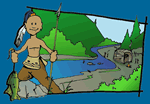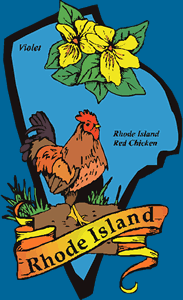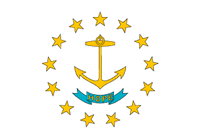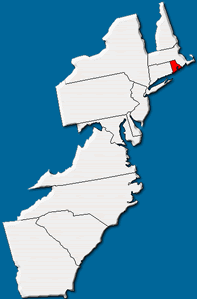 History:
There are legends that the first non-natives to visit Rhode Island were medieval Irish explorers in boats made of animal skins. Later, it is believed that Vikings also briefly explored the area. However, the first explorer we can be sure visited Rhode Island was Giovanni Verrazzano who, in 1524, was looking for a way to China by discovering a water route through North America. After landing in North Carolina, he sailed up the East Coast, and eventually came to an island he described as being "in the form of a triangle, distant from the mainland ten leagues, and about the bigness of the Island of Rhodes." He named the island Luisa after the Queen Mother of France. Today this island is known as Block Island after another explorer, Dutch sailor Adriaen Block, renamed the land for himself.
In 1614, John Smith, best known for helping settle the Jamestown colony in Virginia, also explored and charted the area, and after 1620, settlers from the nearby Plymouth and Massachusetts Bay colonies came to the area to trade with the Narragansett Indians.
The first settler in the area was William Blackstone, an Anglican minister who built a home on a river that eventually was named for him. In 1636, Roger Williams established a settlement he called Providence Plantations. Williams and a small group of followers had left the Massachusetts Bay colony because they wanted more freedom to worship in their own way. The two Narragansett Indian chiefs, Canonicus and Miantonomi, gave Williams a large area of land for his settlement, and other settlers who did not agree with the strict religious views of the Puritans in Massachusetts soon followed. The town of Portsmouth was established in 1638, the town of Newport in 1639, and the town of Warwick in 1642, all begun by men who wanted to worship in a way not accepted by others.
The land for the first settlements was bought from the native Narragansett, largely because of Roger Williams' good relationship with the Indians. Williams wrote "nature knows no difference between European and American (Indian) in blood, birth, bodies..." and did not believe the Indians to be "savages." He traded easily with the Indians because he took the time to learn their language. However, Williams worried that people from other colonies would try and seize land in the area, so he asked for a royal charter from King Charles II of England to assure that the land would be safe from other Europeans. The charter of 1663 was unusual because it guaranteed complete religious liberty, and established a completely autonomous self-governing colony. At that time, the colony received the name it still has today: Rhode Island and Providence Plantations. Ironically, the state with the smallest area of land has the longest name!
The fact that Rhode Island guaranteed religious freedom led many others with unpopular religious views to settle. The first Baptist church in North America was formed in Providence in 1639, the Quakers established a meeting house in 1657, the first Jewish congregation in the colonies was founded in Newport in 1658, and French Huguenots (later called Calvinists) settled in 1686.
In time, the increasing number of white settlers in the area led to conflict with the Indians. The nearby Plymouth colony was aggressive in its attempts to settle more land, eventually leading to a conflict called King Philip's (the European name given to the Narragansett chief Metacom) War. This conflict affected the colony of Rhode Island as well and lives were lost on both sides. By 1676, however, when King Philip was killed, the war came to an end. Famine and disease had so greatly decreased the number of Indians in the area that European interests dominated from that point forward.
European settlements grew in the area, and by 1774, there were nearly 60,000 residents living in 29 different settlements. Large farms, using both Indian and black slaves, grew in the area. The settlers planted apple orchards, and forests provided lumber. The Atlantic Ocean gave the settlers fish for food and fertilizer, and the beginning of the whaling trade which would become much more important in the 19th century.
As colonial America grew, Rhode Island's stance as an independent colony brought it into conflict with the British, and residents became the first to openly defy England by burning The Gaspee, a British ship in Narragansett Bay in 1772. On May 4, 1776, Rhode Island was the first colony to declare itself independent from Great Britain. Following the war, however, Rhode Island was the last of the thirteen colonies to ratify the new US Constitution. In keeping with its history of independence, delegates were concerned that the new Constitution did not adequately protect individual rights. |









